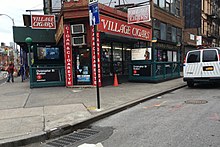Hess triangle


The Hess triangle is a triangular tile mosaic set in a sidewalk in New York City's West Village neighborhood at the corner of Seventh Avenue and Christopher Street. The plaque reads "Property of the Hess Estate which has never been dedicated for public purposes."[1] The plaque is an isosceles triangle, with a 25+1⁄2-inch (65 cm) base and 27+1⁄2-inch (70 cm) legs (sides).[1]
The plaque is the result of a dispute between the city government and the estate of David Hess, a landlord from Philadelphia who owned the Voorhis, a five-story apartment building.[2] In the early 1910s, the city claimed eminent domain to expropriate and demolish 253 buildings in the area in order to widen Seventh Avenue and expand the IRT subway.[1][3][4] By 1913, however, the Hess family had exhausted all legal options.[4] According to Ross Duff Wyttock, writing in the Hartford Courant in 1928, Hess's heirs discovered that, when the city seized the Voorhis, the survey had missed this small corner of Plot 55 and they set up a notice of possession.[1] The city asked the family to donate the diminutive property to the public, but they chose to hold out and installed the present, defiant mosaic on July 27, 1922.[5][6]
In 1938 the property, reported to be the smallest plot in New York City, was sold to the adjacent Village Cigars store for US$100 (equivalent to $1,839 in 2020).[7] Later, Yeshiva University came to own the property, including the Hess Triangle, and in October 1995[8] it was sold by Yeshiva to 70 Christopher Realty Corporation.[9] Subsequent owners have left the plaque intact.[4][10]
References[]
- ^ Jump up to: a b c d Kim, Betsy (August 4–10, 2011). "Tiles Underfoot Recall Owner Who Put His Foot Down". The Villager. 81 (10). NYC Community Media. Archived from the original on March 5, 2016. Retrieved September 13, 2014.
- ^ McKinley, Jesse (April 16, 1995). "F.Y.I." The New York Times. Retrieved September 13, 2014.
- ^ Carlson, Jen (April 9, 2015). "The Story Behind Hess Triangle, Once The Littlest Piece Of Land In NYC". Gothamist. Archived from the original on April 9, 2015. Retrieved April 9, 2015.
- ^ Jump up to: a b c Guiberteau, Olivier. "New York's cheeky symbol of defiance". BBC. Retrieved March 16, 2019.
- ^ "Hess Triangle". RoadsideAmerica.com. Retrieved September 13, 2014.
- ^ Carlson, Jen (November 1, 2010). "Hess's Old Teeny Tiny Message to City". Gothamist. Archived from the original on June 14, 2016. Retrieved September 13, 2014.
- ^ Barron, James (February 10, 2019). "Grace Notes: How a 25-Inch Plot of Land in Greenwich Village Embodied 'a Resistance'". The New York Times. Retrieved February 10, 2019.
- ^ "Deed, Sec. 2, Block No. 591, Lot 54". New York City Department of Finance, Office of the City Register. October 18, 1995. p. Reel 2256, Page 0368. Retrieved June 1, 2020.
- ^ Snetiker, Lauren (September 25, 2015). "Hess Triangle: What was Once the Smallest Piece of Property in New York City". Greenwich Village Society for Historic Preservation. Retrieved June 1, 2020.
- ^ Plitt, Amy (July 17, 2017). "In the West Village, a remnant of NYC's onetime smallest plot of land remains". Curbed. Retrieved December 2, 2017.
Coordinates: 40°44′01″N 74°00′11″W / 40.733513°N 74.003067°W
- Christopher Street
- West Village
- Individual signs in the United States
- 1922 establishments in New York (state)
- Triangles
- 20th century in New York City
- Real estate holdout
